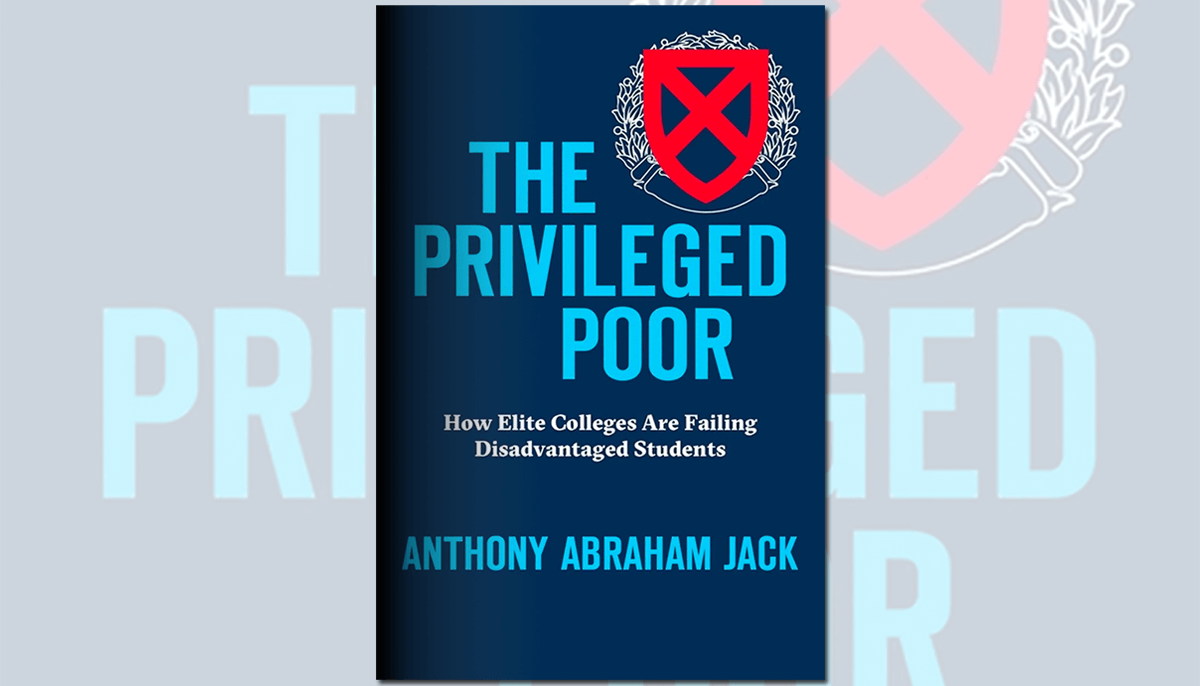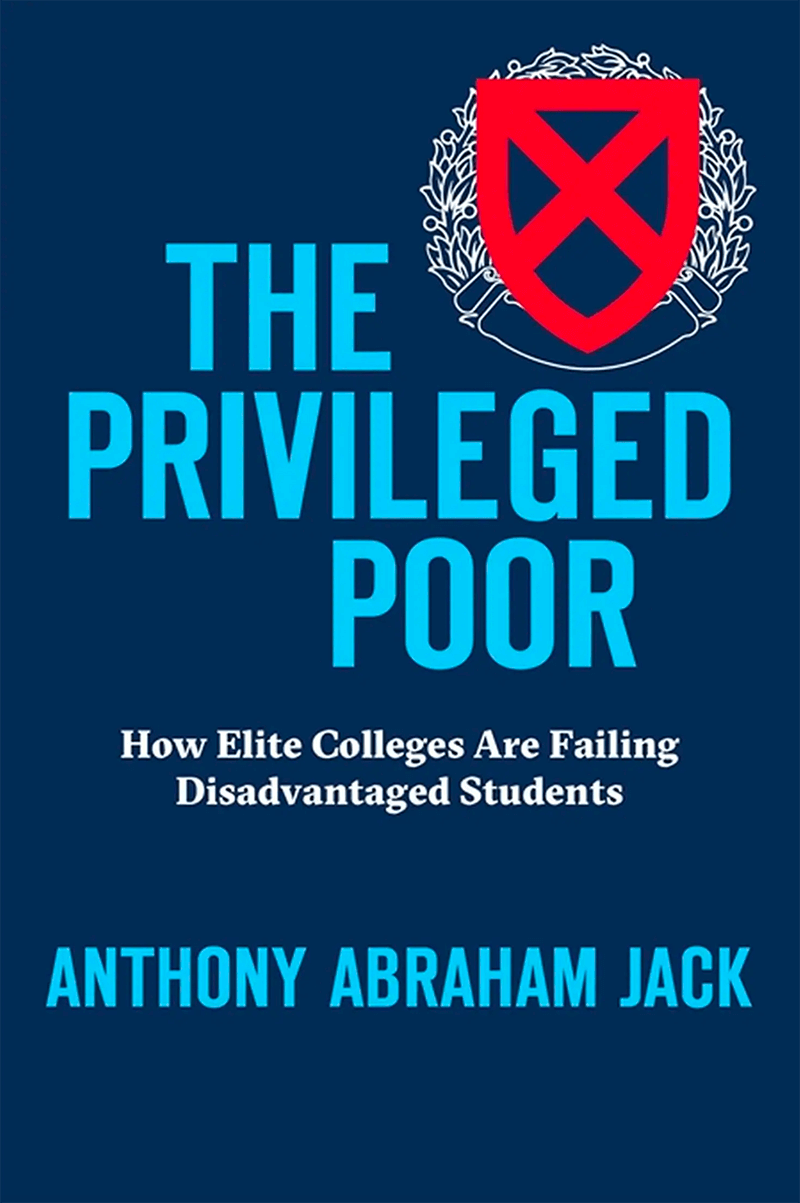
The Privileged Poor: How Elite Colleges Are Failing Disadvantaged Students
by Anthony Abraham Jack
Harvard University Press, 2019, $27.95; 288 pages.
As reviewed by Matthew M. Chingos
Elite institutions such as Harvard, Princeton, and Amherst have worked to increase socioeconomic diversity on their campuses, with many implementing generous “no loan” financial-aid policies for low-income students over the last 20 years. But Harvard education professor Tony Jack argues that our country’s leading undergraduate institutions are, despite the best of intentions, failing many of their disadvantaged students.
Jack’s powerful new book, The Privileged Poor, is based on years of in-depth interviews with more than 100 students from diverse backgrounds on an unnamed campus he calls “Renowned University.” The author chronicles how students’ socioeconomic and academic backgrounds jointly shape their experiences living and learning on a campus where roughly one third of students come from families wealthy enough to pay the full tuition cost—and only 13 percent are the first in their family to attend college.
The book’s key insight is that treating poor students as a homogeneous group will lead to undifferentiated practices that fail to accomplish institutions’ goals as they seek to change from bastions of privilege to engines of social mobility. Jack’s organizing distinction is between the “privileged poor” of the book’s title—who attended elite private high schools on scholarship—and their “doubly disadvantaged” peers, who attended under-resourced public schools.
The privileged poor arrive on campus having already learned how to navigate elite institutions and to coexist with peers from both poor and wealthy families; one such student “strategically chose when to chronicle her family’s financial hardships and when to showcase her knowledge of France’s hidden gems.” But the doubly disadvantaged struggle to cope with the culture shock of a place unlike any they’ve experienced before, and the feeling that, in one student’s words, “everything you do here is at someone else’s mercy.”
 At the same time, the privileged poor cannot escape the fact that they are poor. Jack describes the common challenges all disadvantaged students face, such as going hungry while dining halls are closed over spring break and the stigma of cleaning the toilets in their classmates’ dorm rooms (an attractive job only because it pays better than others).
At the same time, the privileged poor cannot escape the fact that they are poor. Jack describes the common challenges all disadvantaged students face, such as going hungry while dining halls are closed over spring break and the stigma of cleaning the toilets in their classmates’ dorm rooms (an attractive job only because it pays better than others).
The book has clear implications for institutional policy, and Jack reports that the unnamed university he describes has already made some progress in addressing the institution-specific issues he has identified. More broadly, Jack encourages colleges to provide more opportunities for students to learn about each other, such as through events that bring randomly selected students together without a “diversity” label.
Jack also pushes institutions to address a major challenge faced by the doubly disadvantaged at elite colleges: the “hidden curriculum full of unwritten rules, unexplained terms, and a whole host of things that insiders take for granted.” Simple things such as professors explaining what “office hours” are on the first day of class can make a difference. Jack also highlights examples of universities that work to foster faculty-student interactions—especially for students who may not be comfortable reaching out to professors on their own.
The student perspectives represented in the book are rounded out by Jack’s inclusion of 27 upper-income black students, whose smooth transitions in college mirror those of the privileged poor in many ways. But the book says little about the role of relatively affluent students—who make up the lion’s share of the student body—in creating an inclusive campus. As Jack points out, “poor students are often asked why they won’t go out for dinner or to a dance club, but no one is asking rich students to justify spending $30 for a lobster.”
If elite colleges want to create an inclusive environment, perhaps their admissions offices should change the factors they consider when admitting affluent students, such as whether they attended diverse high schools. Selective institutions have thousands of well-qualified applicants from which to choose. It seems to me that modest changes in how those decisions are made might help create a campus culture where students are embarrassed to be seen in a $700 winter jacket, or at least an environment without the sorority leaders who “commanded new recruits to take selfies with the homeless people who occupy the benches and stoops around the campus.”
The book’s implications for K–12 education policy are less clear. One obvious inference might be that we should open the prep-school gates to more poor students—turning them from the doubly disadvantaged into the privileged poor. But Jack rejects this idea, arguing that public dollars that might support private-school scholarships would be better used to help public schools improve.
What happens on the campuses of elite colleges and universities, which enroll a tiny fraction of American students, should not inform broader policy decisions about how K–12 and higher education are funded. But if we accept that there is value in broadening access and inclusion for poor students at elite institutions, then I think we also need to grapple with whether public policy should do more to support the enrollment of poor students at elite private high schools.
Jack points out that “elite colleges may be few in number, but their influence—on the lives of individual students and on American society as a whole—is outsize.” The amount of public support needed to help more low-income students attend elite private high schools would likely be very small—just as the Pell grants that support the enrollment of disadvantaged students at elite colleges is a small slice of the federal higher-education budget.
Tony Jack begins his book by describing his own privileged-poor background: he attended a private high school on scholarship before going on to earn degrees at Amherst and Harvard. Together, Jack and the students who poured their hearts out in his interviews have shed new light on “the gap between the lengths a university can go to make its education accessible and the blind spots that keep it from making that education truly inclusive.”
Matthew M. Chingos is vice president for education data and policy at the Urban Institute.


